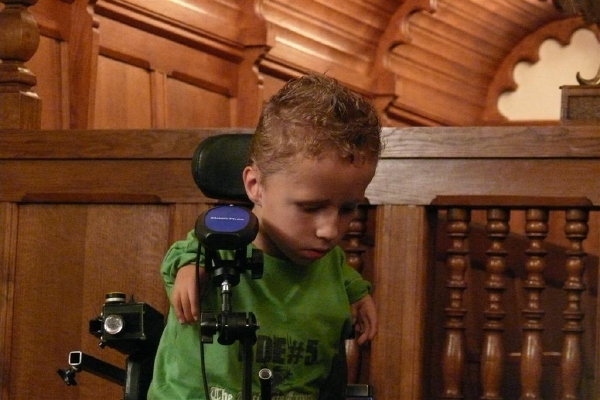Other instruments
Electronic music is music for everyone
Ruud van der Wel, respiratory therapist, rehabilitationcentre Rijndam.
Music plays an important role in the development of humans cognitively, socially and emotionally. Music itself is for many a big party. But what if you, because of a disability, can’t play a traditional instrument? Are you limited to only listening to someone else playing an instrument? No.
There is actually very little information about the possibilities for making music by people with a significant physical disability. Nevertheless, there are many posibilities! In this article you will not find the traditional acoustic instruments: the custom flute, violin and guitar are not discussed. We focus only on electronic instruments and computer related applications. This is because many adaptive solutions can readily be found.
We can devide the Electronic instruments into three groups:
1.Especially for this target group developed electronic musical instruments,
2. Existing electronic instruments, often with some adjustments made suitable for our target group,
3. Computers with special interfaces and music software.
The solution chosen is highly dependent on the disability. Someone who makes many involuntary movements will not go for a solution where timing is essential. Someone with a muscular disorder does have the control, but not the muscle strength.
There is also a price difference between the three groups. A specially designed device is more expensive than a mass produced product. A specially designed instrument will be most likely more consumer friendly to use than for example a computer.
Background
MIDI
Some tools are so called MIDI controllers. MIDI is an industry-standard protocol defined in 1982 that enables electronic musical instruments such as keyboard controllers, computers, and other electronic equipment to communicate, control, and synchronize with each other A MIDI controller itself does not make sound. The most well known MIDI controller is the MIDI keyboard. A MIDI controller only sends MIDI messages to an external sound source. The external source is a keyboard, sound module or music computer. The external source has a MIDI input.
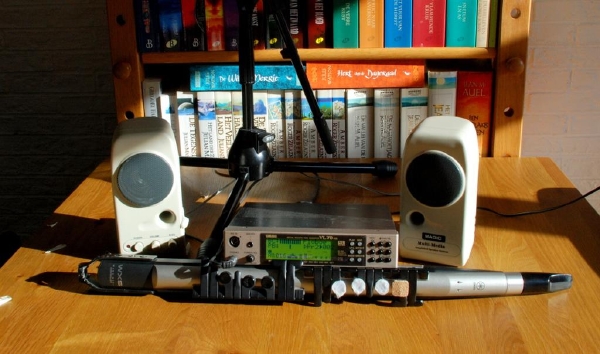
An electronic wind instrument with external sound module and computer speakers.
Stand-alone
With stand-alone we mean that the devices can work completely independently, so it is just a matter of turnig the power on and play. These are the most user-friendly music tools. Some stand-alone instruments even have internal speakers.
To have an instrument accessible for our taget group we often will have to make small adjustments. An electronic wind instrument has to be adapted so that it can fit on a low microphone stand . A synthesizer, such as the Korg Kaossilator, has very small menu buttons that can be adjusted so that the device can be operated used with easy to operate switches.
Switch
With a switch you can turn something on or off. In daily life we use all kinds of me switches. The kind of switches – the light switch, the power on/off switch on your computer. And the keys of your computer keyboard are all switches too!
The switches specially designed for disabled people are doing the same job as switches we use in daily life – a simple device for turning something either on or off, no more and no less.
If we look at the switches for disabled people we see that there are several solutions. There are simple buttons, there are switches that you can controll with the side of your head, eye blink switches, eyebrow switches, sip and puf switches. There are even switches that respond to brain activity (such as Brain Fingers).
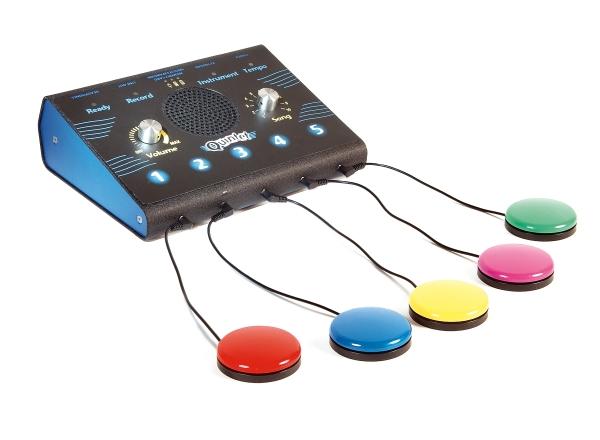
The Quintet with five button switches.
The following list will probably not be complete. But all discussed have been tested in practice and is used daily by children with severe motor disability at rehabilitationcentre Rijndam This article is best to be read while watching some introduction videos. They can be viewed at www.myspace.com/muzieksleutel. You can also post feedback on this website.
Specially developed electronic musical instruments
The Sound Beam
The Sound Beam is a MIDI controller. It sends an (invisible) ultrasonic signal. Move the hand, head or a wheelchair through this beam and the sound is triggered.
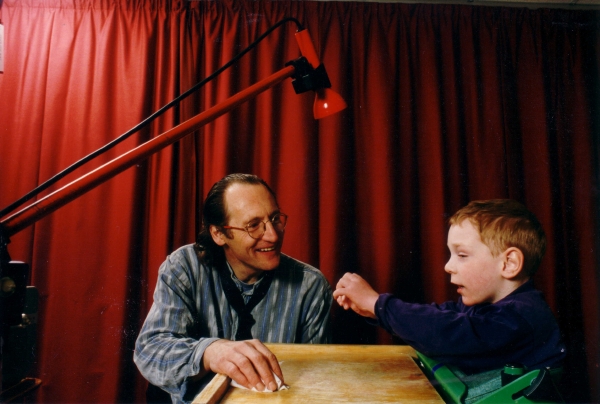
The Quintet
The Quintet is a stand-alone device where you can connect up to five switches. It holds a number of pre programmed songs. The Quintet is perfect for playing in a group, where each participant has his own task within a given track.
The Magic Flute
The Magic Flute is a stand-alone instrument. It is an electronic wind instrument that can be played without hands. You can play songs or play improvised music.
The Magic Flute has two seperate parts, a flute and a control module with a display. The flute is also the remote control for the control mudule. The musician can select a different sound or access the user settings without the help of another person. In the picture Karin van Dijk plays The Magic Flute. Despite her limited lung volume she can produces maximum sound, That is one of the benifits of playing an electronics instrument.
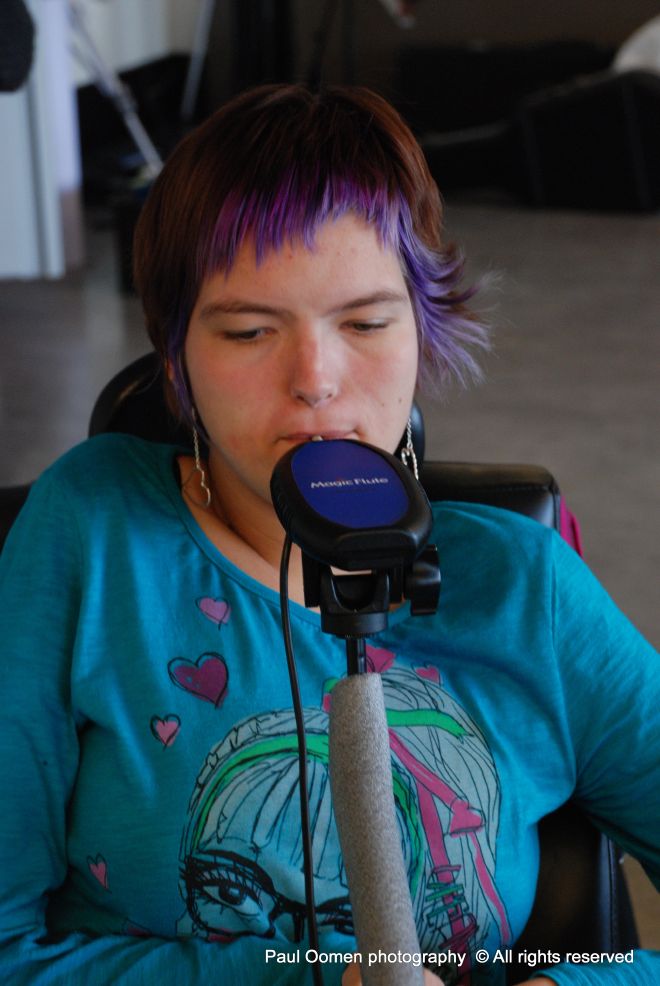
Existing electronic musical instruments
The WX11 and WX5 by Yamaha
These electronic wind instruments are MIDI controllers. They are particularly suitable for people with limited strength. There are other brands wind controllers in the market, but they are less suitable.
The Kaossilator
The Korg Kaossilator is a pocket synthesizer. Pocket here means that it fits in your pocket. The Kaossilator is played by running a finger across the touch pad.
Electronic keyboards
There is a huge range of keyboards. A choice may be based on whether the keys needs little strenght to play. Often older types are better suited because they are not velocity-sensitive. Sensitive means that the loudness of the notes played depends on the force used by the player. An example of a particularly suitable keyboard is the Yamaha DJX-2. This keyboard is made for DJs and empathize very well from the perception of adolescents.
Electronic Percussion
There is a fairly wide range. Here too the choice is often based on whether the drum sounds can be played with minimum force. The Yamaha DD-60 has a percussion setting which can be used to make it playable. It has built-in speakers.
Computers with special interfaces and music software
There are three music software programs specifically designed for people with severe disabilities. The big advantage of the computer is that different combinations of applications can be made. To connect a switch to a computer you’ll need a USB switch interface.

USB switch interface
Switch Jam and Switch Ensemble
These two programs come from the United States. They are very accessible music programs, easy to set up. You use switches to trigger musical activities.
In a Switch Jam you are one of the four musicians. You can sing, play saxophone, flute, keyboard and (bass) guitar by using a switch.
Switch Ensemble is a music player. Every time you hit the switch a piece of music is performed. Such a piece of music is called a phrase. A song is chopped in phrases. You can also load your own pieces of text or music.
So someone with speech problems still can sing a song!
E-Scape
Also in this program you use one or more switches to trigger music. But it goes even further than that. The program is completely controlled with a single or more switches. This Includes the menus, selecting tools, selecting the songs, anything can be done by the musician himself. It is possible to compose your own music and then save it to disk. Later you can resume your composition. You can perform your own compositions or perform someone else’s. It can also be played with multiple players simultaneously. There is a Dutch version of this program.
E-Scape will let you do almost anything that can be done with other well known MIDI music sequencing program (Cubase, Logic etc.). Music Sequence programs are quite complex. E-Scape is no exception, but the user can do things beyond imagination.
Grid Play
This program shows a number of Grids (squares) on the computer screen. Every grid can produce a sound. You use your mouse pointer in combination with the right mouse button to trigger the sounds. At the rehabilitation centre where I work there are kids that can use a mouse pointer but handling the mouse buttons is imposible for them. Fortunately there is a simple software solution available: “Sticky right mouse button.
Grid Play is easy to use. One can load different grids. The activity is especially fun for children who have to learn to use the mouse pointer.
Availability
Some of the equipment is no longer commercially available. These are the Yamaha WX11 and the Yamaha DJX II keyboard.. For those instruments you are mainly dependent on the used market. The Yamaha WX5 is no longer available in Europe but still in the rest of the world.
In the case of the WX5 and WX11, the Non profit organisation “My Breath My Music can help in finding a good used instrument.
• The Magic Flute and Quintet are available from the company Audio Rhoon (info@audiorhoon.nl)
• Sound Beam at www.moreinmusic.com
• E-Scape email to the author Tim Anderson (timanderson@inclusivemusic.org.uk)
• Switch and Switch Ensemble Jam at www.switchintime.com
• GRIDPlay www.fullpitcher.co.uk
• The USB switch interface www.xkeys.com
The other instruments in this article are from the regular music store.
